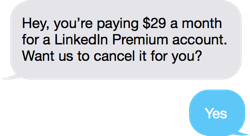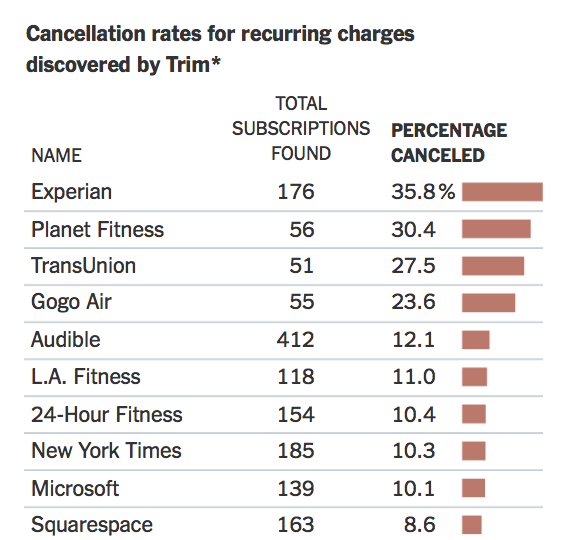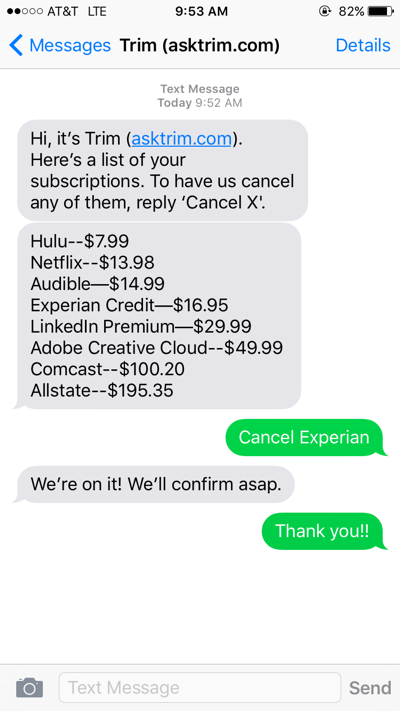 You’ve heard the financial media (and me) talk about the importance of automated savings. Things like recurring 401(k) contributions that don’t require flexing your willpower. Well, the other side of the coin is automated spending. Companies love love love it when you buy their stuff on auto-pilot.
You’ve heard the financial media (and me) talk about the importance of automated savings. Things like recurring 401(k) contributions that don’t require flexing your willpower. Well, the other side of the coin is automated spending. Companies love love love it when you buy their stuff on auto-pilot.
A new start-up called Trim helps you identify your recurring charges automatically and cancel the unwanted ones for you, for free. That sounded like a great idea. You’ll have to provide them the login credentials to your credit card or bank account, or you can snail mail them your statements. (I’d say yes to credit card before bank account.) This is going to sound like a humblebrag, but I wanted to test the service out but don’t have any services that I want canceled. Instead, I had a quick e-mail exchange with Trim CEO, Thomas Smyth:
Me: Trim sounds very interesting. Instead of a phone call, do you mind me asking just how exactly do you cancel the service on behalf of customers? I can understand the algorithmic finding of recurring charges, but wouldn’t you need some detailed personal information in order to perform the cancellation? If so, what type of info would you ask people for?
Thomas Smyth, Trim CEO: Absolutely – it just depends on the biller. For some, like Hulu, we simply send a form email that has the user’s account info (email, name) and the most recent charge on the credit card. For others, like credit reports or gyms, we’ll ask the user for more info, like DOB and account number.
We never ask for confidential info like SSN or full credit card numbers — those are NOT safe to send via text message. Sometimes we do run into billers that require this info — for example, LifeLock. In those situations we can’t cancel it for you (sorry!) but we do send you detailed info on how to cancel it yourself.
So they will try, but it won’t work for every biller. In those cases, hopefully them pointing out your wasteful ways will nudge you towards action. The good news is that the NY Times profiled Trim recently and found it to work pretty well. They even broke down the recurring subscriptions with the highest overall cancellation rates by Trim. Here are just the top 10:

You could read this as the most overlooked services, or the hardest to cancel, or a combination. People tended to want to get rid of their credit monitoring services, gym membership, and Gogo Air the most. The vast majority of people kept their Netflix and Spotify. The New York Times itself gets canceled 10% of the time it is found, so I suppose it is rather brave of them to even point this service out!
Amazingly, they don’t have an app! Trim has an online web interface, but the original service works simply over text messages.

Free identification and cancellation services are nice. But canceling will always be harder than signing up, so I try to avoid them in the first place. Automate your savings, not your spending.
Related: SubscriptMe is an app that identifies recurring subscriptions by scanning your phone. There are also haggling services like Bill Fixers which charge a finder’s fee based on how much money they save on your behalf.
 The Best Credit Card Bonus Offers – 2025
The Best Credit Card Bonus Offers – 2025 Big List of Free Stocks from Brokerage Apps
Big List of Free Stocks from Brokerage Apps Best Interest Rates on Cash - 2025
Best Interest Rates on Cash - 2025 Free Credit Scores x 3 + Free Credit Monitoring
Free Credit Scores x 3 + Free Credit Monitoring Best No Fee 0% APR Balance Transfer Offers
Best No Fee 0% APR Balance Transfer Offers Little-Known Cellular Data Plans That Can Save Big Money
Little-Known Cellular Data Plans That Can Save Big Money How To Haggle Your Cable or Direct TV Bill
How To Haggle Your Cable or Direct TV Bill Big List of Free Consumer Data Reports (Credit, Rent, Work)
Big List of Free Consumer Data Reports (Credit, Rent, Work)
Seems like a nice service, but my first thought was that the fiscally responsible readers of MyMoneyBlog would never get themselves into this situation in the first place!
It happens as your life gets busier and more complex with age, children, business, etc. Would be nice if you asked him (and all of these “free” or “lost cost” internet services) how they intend to make money/stay in business in the future. Gives us insight into how legitimate they are or how long they’ll be around. Thanks
If only they could help get a Vivint home security subscription cancelled. That’s one of the worst services to cancel in the nation, and normally will involve an unsubstantiated debt being sent to collections (because they keep billing after you cancel). If only I knew the things I know now when I first signed up, I would never have contracted with them.